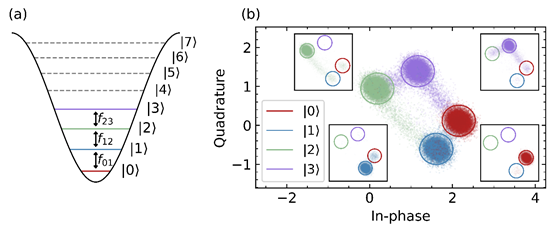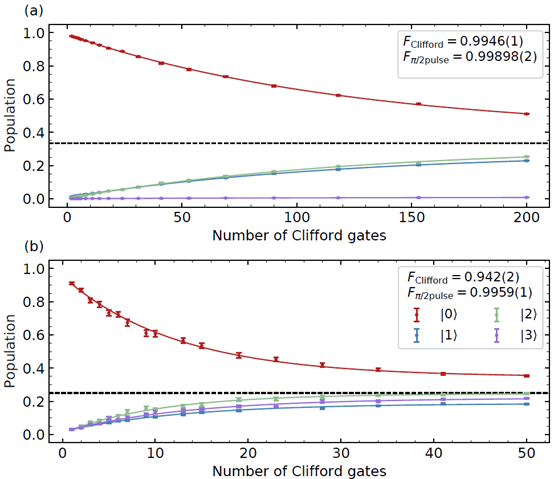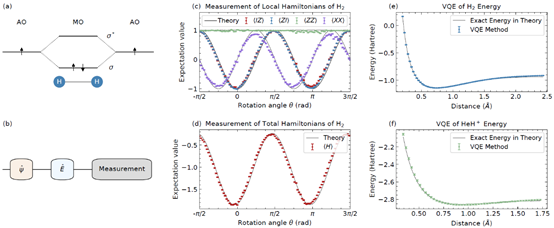New Progress of Superconducting Qudit Systems
2023/05/26
Recently, new progress has been made in high-dimensional quantum computation by the Superconducting Quantum Computation Group of Beijing Academy of Quantum Information Sciences and Professor Li You’s team from the Department of Physics at Tsinghua University. The feasibility of a multi-level system based on a superconducting transmon as a quantum computing unit has been experimentally verified. This achievement has been published under the title of “Performing SU(d) Operations and Rudimentary Algorithms in a Superconducting Transmon Qudit for d = 3 and d=4” in Physical Review X, a journal of the American Physical Society, on May 23, 2023.
Usually, the quantum computing unit is a two-level quantum system, or a qubit. However, most physical systems that are used to implement quantum computation contain many levels, among which two are chosen to encode a qubit. A natural question is whether it is feasible and advantageous to choose more than two levels to encode quantum information, or to use d-level quantum systems (qudits with d>2) as quantum computing units. The most straightforward advantage comes from the scaling of the computational-space dimension. As the number of computing units increases, the qudit-based computational-space dimension grows as dN, which is better than 2N for the qubit-based quantum computation. Using qudits also has advantages such as reducing the complexity of quantum circuits, simplifying the experimental setup, and improving algorithmic efficiency. In fact, the quantum computation communities working on different physical systems, such as trapped ions, quantum optics, cold atoms, nuclear magnetic resonance systems, and magnetic molecules, have been actively exploring this issue in recent years and have made good progress.
The transmon is commonly used as a qubit in superconducting quantum computing. However, transmon is inherently a multi-level system. To use its higher energy levels for quantum information processing, several problems need to be solved: (1) The lifetimes of the transmon need to be long since the lifetimes of the -th excited energy level is roughly of the first excited energy level. (2) High-fidelity direct readout of low-lying energy eigenstates is required. (3) A universal quantum gate set needs to be developed and calibrated. Thanks to the previous fundamental work on long-coherence-time superconducting transmons, appropriate transmon samples have been designed and prepared by the superconducting quantum computation team. The samples not only have long coherence times for the first three excited states but also achieve readout fidelity of over 91% for the four low-lying energy eigenstates without using the Josephson parametric amplifier (Figure 1). With these transmon samples, researchers experimentally calibrate a universal gate set for a qudit, propose and demonstrate the optimal decomposition scheme for arbitrary unitary operations in a qudit system. They prepare quantum superposition states in both of the three-level and four-level systems and characterize them using quantum state tomography, with measured state fidelities reaching 99%. For unitary operations, the researchers use quantum process tomography and randomized benchmarking to characterize the Clifford gates. The average fidelities of a Clifford operation are measured to be 99.46% (d=3) and 94.2% (d=4) (Figure 2). Furthermore, several basic quantum algorithms are demonstrated, including the discrete Fourier transform (DFT), Grover’s search algorithm, and the quantum variational eigensolver in quantum chemistry (Figure 3). The experimental results demonstrate the accuracy and efficiency of the qudit as a quantum computing unit. This work lays the foundation for qudit-based superconducting quantum computation, and may inspire more theoretical and experimental interest to explore quantum computation with multi-qudit systems.
The first author of the paper is Pei Liu, a PhD candidate jointly trained by Beijing Academy of Quantum Information Sciences and the Department of Physics at Tsinghua University. The corresponding authors are Associate Researcher WeiyangLiu and Associate Researcher Jing-Ning Zhang from Beijing Academy of Quantum Information Sciences. Professor Li You from Tsinghua University has been providing considerable guidance during the preparation. The work has been supported by the National Natural Science Foundation of China and the Beijing Natural Science Foundation.

Fig. 1 (a) Energy-level structure of a superconducting transmon. (b) Direct readout signals of the first four energy eigenstates.

Fig. 2 Randomized benchmarking for a qudit with (a) and (b) .

Fig. 3 Quantum variational eigensolver for solving the ground-state energies of the hydrogen molecule H2 and the helium hydride ion HeH+.
Link: https://journals.aps.org/prx/pdf/10.1103/PhysRevX.13.021028
 中文
中文 Email
Email QCloud
QCloud Log in
Log in
